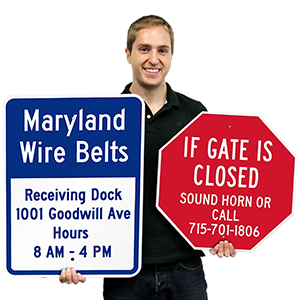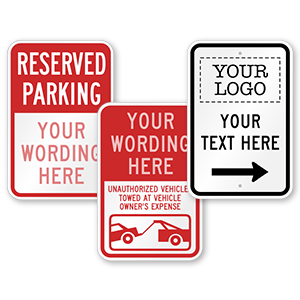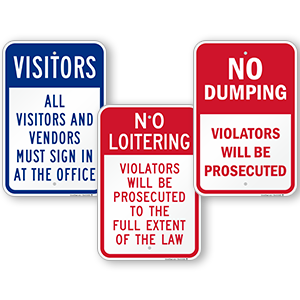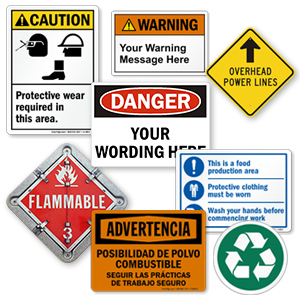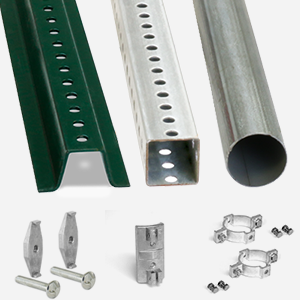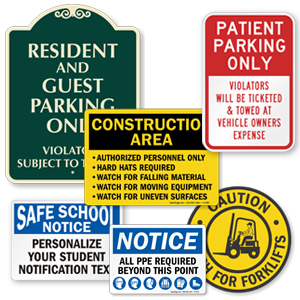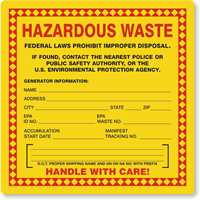By Prokopis A. Christou
Introduction
Daily, millions of packages containing hazardous materials are transported throughout the world and reach their destinations uneventfully, thanks to international shipping standards and the diligent care of shippers and carriers. Labels that are affixed to the packages play a significant role in this success. The labels alert handlers of the hazards associated with the package contents. When accidents do occur, labels aid in hazard and material identification for an appropriate response to the emergency.
The big picture
International standards, such as the United Nations (UN) recommendations for the transportation of dangerous goods, and national standards lay out the framework that made this high level of safe transport possible—protecting public safety, the environment, and property. In the United States, the U.S. Department of Transportation (DOT) developed the Hazardous Materials (HM) regulations to promote the safe transportation of hazardous materials. (Hazardous materials are referred to as dangerous goods in international commerce.)
The HM regulations make the shipper legally responsible to identify the hazards of a material to be shipped, select the right packaging, and prepare the shipment so that it will arrive safely at its destination. Four different forms of hazard communication information accompany most hazmat shipments: a shipping paper, markings, labels, and placards.
The shipping paper provides written, detailed information about the shipment. Labels are affixed on containers to provide a warning about the hazards of the contents. Markings are placed on containers and transport vehicles to provide material identification and additional information about the shipment. Those markings may be handwritten or stenciled right on the package. Placards are affixed on large packages and transport vehicles to warn of the hazards of the shipment and to permit visual inspection from a distance. All four means of hazard communication work together to promote safe handling and, if necessary, a safe response.
What exactly are hazmat labels?
A label is a piece of paper or other material inscribed and affixed to a package or container for identification or description. In plain language, a label contains printed or handwritten information about the shipment or the package. It may be of a standardized design and self-adhesive. Technically, some hazmat labels are considered markings according the regulations; however, most shippers use labels because they are usually more legible and the possibility for errors is reduced. Label users can either purchase the labels from label vendors or print them on demand using specialized software.
The HM regulations require that a nonbulk (< 119 gallons) hazmat package be marked with the material's Proper Shipping Name (PSN), United Nations/North American (UN/NA) identification number, and name and address of the consignor or consignee. Additional markings may be required depending on the material and shipment. Examples of these markings include the ISO orientation arrows for liquids in combination packaging and "RQ" with the PSN for hazardous substances.
DOT labels are 100 mm X 100mm square on point labels. Their design is federally regulated. Each DOT label corresponds to a DOT Hazard Class or Division Number. A label for the material's primary hazard displays the Hazard Class/Division number on the bottom corner. A label for subsidiary hazards must not display the Class/Division number on the bottom corner.
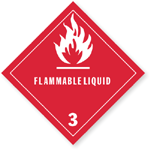
Flammable Liquid
Label
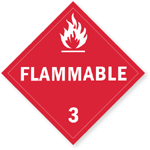
Flammable
Placard
Fig. 1: Labels and placards are not identical.
DOT placards are similar to labels, but larger in size (273 mm x 273 mm). Their design is also federally regulated. They are placed on bulk packages and transport vehicles. Placards may be required depending on the shipment. Removable placards are usually printed on vinyl or metal and placed in placard holders attached to a vehicle or package. For long term display, self-adhesive vinyl placards may be used.
How about hazardous waste labels?
What is commonly referred to as a hazardous waste label is a self-adhesive label designed by label manufacturer or the user. Neither the DOT nor the U.S. Environmental Protection Agency (EPA) requires or specifies a hazardous waste label design. EPA's Resource Conservation and Recovery Act (RCRA) hazardous waste regulations require that a container of 110 gallons or less capacity that contains a hazardous waste be marked with the following information:
"HAZARDOUS WASTE – Federal Law Prohibits Improper Disposal. If found, contact the nearest police or public safety authority or the U.S. Environmental Protection Agency.
Generator's Name and Address _____.
Manifest Document Number ______."
Some state-run RCRA programs require a variation of this notice. Because hazardous waste is also regulated under the DOT regulations, when in transport, the container must also display the appropriate DOT markings and labels. A typical hazardous waste label combines the required DOT and waste markings plus provides space for the user to enter additional mandatory and voluntary information. An example of a hazardous waste label is shown in Figure 2.
How to select appropriate labels?
Table 1 lists the sections of the DOT and
EPA codes applicable to labeling and marking. Once the Proper Shipping
Name is determined, selection of DOT labels starts with the HM Table.
If the material is a hazardous waste, a hazardous waste label is
required.
Table 2 describes the selection
process step by step. The selection process for DOT placards somewhat
mirrors the one for DOT labels. The following examples go through
the process.
Shipping Acetone
A chemical distributor is preparing four 55-gallon drums of Acetone to be shipped from its warehouse to a buyer's site located 50 miles away in the same state. The drums will be transported by truck. The warehouse supervisor determined that Acetone is regulated as a hazardous material, which means that the shipment must comply with the HM regulations.
Let’s confirm this. By reviewing
the HM Table in Section 172.101 we find that Acetone is listed by
name in Column 2 of the Table. The complete entry is shown in Figure
3. From this listing we learn that the DOT has classified Acetone
as hazardous. Its Proper Shipping Name is Acetone (identified in
Column 2). Column 3 lists "3" as its primary Hazard Class.
This means Acetone is a flammable liquid. Column 6 lists codes that
correspond to the DOT labels, in this case the Flammable Liquid
label. If a material also meets additional hazards, Column 6 will
also list label codes for the additional hazards. Only one label
code is listed for Acetone. We review the labeling requirements
(see Table 2) for special labeling provisions.
We don’t find any.
§172.101 Hazardous Materials Table
Symbols
(1)
|
Hazardous
Materials Descriptions and Proper Shipping Names
(2)
|
Hazard
Class or Division
(3)
|
Identifi-
cation Numbers
(4)
|
PG
(5)
|
Label
Codes
(6)*
|
Special
Provisions
(7)
|
(8)
Packaging (§173.***)
|
(9)
Quantity Limitations
|
(10)
Vessel Stowage
|
Ex-
cep-
tions
(8A)
|
Non-
bulk
(8B)
|
Bulk
(8C)
|
Passen-
ger
Aircraft/
Rail
(9A)
|
Cargo
Aircraft
Only
(9B)
|
Loca-
tion
(10A)
|
Other
(10B)
|
| |
| |
Acetone |
3 |
UN1090 |
II |
3 |
T8 |
150 |
202 |
242 |
5
L
|
60
L
|
B |
|
| |
| |
Flammable
liquids, n.o.s.
|
3 |
UN1993 |
III |
3 |
B1,B52,T7,
T30
|
150 |
203 |
242 |
60
L
|
220
L
|
A |
|
|
*Label Codes: 1.1, 1.2, 1.3, 1.4, 1.5 and 1.6 – Explosive; 2.1– Flammable Gas;2.1– Flammable Gas; 2.2– Non-Flammable Gas; 2.3– Poison Gas; 3– Flammable Liquid; 4.1– Flammable Solid; 4.2– Spontaneously combustible; 4.3– Dangerous When Wet;5.1– Oxidizer; 5.2– Organic Peroxide;6.1– Poison Inhalation Hazard; 6.2– Infectious Substance; 7– Radioactive;
8– Corrosive; 9– Class 9
|
Fig. 3
Now we are ready to prepare the shipment. We verify that the type of drums that contain the Acetone is authorized packaging and that it meets the Packing Group performance level listed in Column 5 of the HM Table. We mark each drum with the Proper Shipping Name and UN number (Acetone, UN 1090) and affix a primary hazard Flammable Liquid label on the same surface. Then each drum is labeled with the name and address of the shipper (us) and the consignee (the person or company we are shipping to). We make sure that each drum is in good condition and that the closures are tight. We verify that the information on the Bill of Lading complies with regulatory requirements for shipping description and make sure that the labels and the Bill of Lading match. A drum that is ready for shipment is shown in Figure 4.

|
1. Address Label
From:
Tel. 1-800-ACME-100
ACME Distribution Co. Inc.
123 Distribution Rd.
ACME, NJ 07002
To:
Tel. 1-800-THE-BEST
Best Products, Inc
321 Best Rd.
Excellent City, NJ 07002
|
|
|
| 2. Proper Shipping Name and UN/NA# |
3. Flammable Liquid Primary Label
4. Orientation Arrows - Optional for single pakaging.
|
|
Fig. 4
Shipping Hazardous Waste
A manufacturer of chemicals uses a petroleum product to clean the interior of a chemical reactor during maintenance. The cleaning process generates a liquid waste that is regulated as a DOT flammable liquid and as a RCRA hazardous waste. The liquid waste is collected in ten 55-gallon drums that will be transported by truck off-site for proper disposal.
According to the environmental department the shipping description for the material is "Waste, Flammable Liquid, NOS, 3, UN 1993, PG III, (Kerosene, Naphthalene), RQ (D018)". The HM Table entry for Flammable Liquid NOS Packing Group III is shown in Figure 3. Column 6 for the entry lists "3" as the label code. As a result, a Flammable Liquid label is required for each drum. Because the drum contains a hazardous waste, we need a hazardous waste label. We enter the required waste and DOT markings on the hazardous waste label and affix it on the side of the drum. We then place a primary hazard Flammable Liquid label next to the waste label. The rest of the preparation requirements are identical to the previous example, except that we must use the hazardous waste manifest instead of a Bill of Lading form, and include additional markings for technical names and hazardous substances. A completed package is shown in Figure 5.
 |
|
1. Orientation Arrows - Optional for single packaging.
2. Hazardous Waste Label
3. Flammable Liquid Primary Label |
|
Fig. 5
Conclusion
The standardized labels and markings on packages that contain hazardous materials are a valuable resource to everyone who must rely on that information to protect themselves, the public, property, and the environment.
Copyright © 1998 Prokopis A. Christou ([email protected])
Notice: this article is intended to provide general information. Readers are advised to review the most current applicable regulations to verify detailed requirements.
Tables
| DOT labeling requirement can be found at the following sections of 49 CFR |
172.400
172.400a
172.401
172.402
172.403
172.404
172.405
172.406
172.407-450
|
General Labeling Requirements
Exceptions From Labeling
Prohibited Labeling
Additional Labeling Requirements
Class 7 (Radioactive) Material
Labels for Mixed and Consolidated Packaging
Authorized Label Modifications
Placement of Labels
Label Specifications |
| Required DOT markings can be found starting at 49 CFR 172.300 |
| Required RCRA hazardous waste markings can be found at 40 CFR 262.32 |
Table 2. How to select labels for a non-bulk hazmat package.
A. DOT labels
- Classify the material according
to the hazard class criteria and select an appropriate Proper
Shipping Name from Column 2 of the HM Table (Section 172.101)
- The required labels are specified
in Column 6 of the HM Table for the selected Proper Shipping
Name. The label codes are explained at 172.101(g). The general
labeling requirements are explained at 172.400.
- The label for the primary
hazard, which corresponds to the Hazard Class/Division number
listed in Column 3 of the table, must display the Class/Division
number on the bottom corner of the label. The labels for
the subsidiary hazards must not display the Class/Division
number.
- The label must meet the DOT
design specifications.
- Generally only one label for
each hazard is required. It must be located on the outside
surface of the completed package near the markings for the
Proper Shipping Name. It must be visible, in contrast with
the background surface, and unobstructed from attachments.
Do not place the labels on the bottom of the package.
- Review the labeling requirements
for exceptions, special provisions, and additional labeling
requirements.
B. Hazardous waste labels
Determine if your state’s
hazardous waste regulations require "wording" which
is different that of the Federal waste rules. Use a label
that contains the required language plus space for entering
shipment and DOT markings. |


